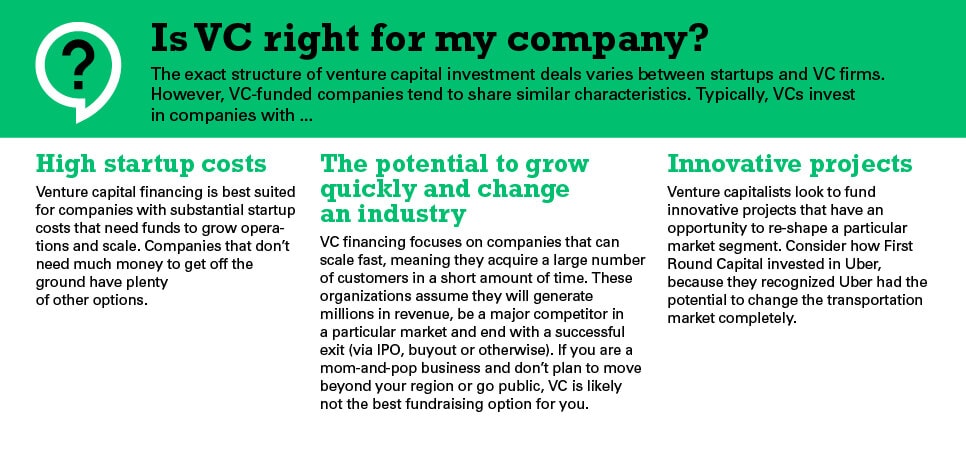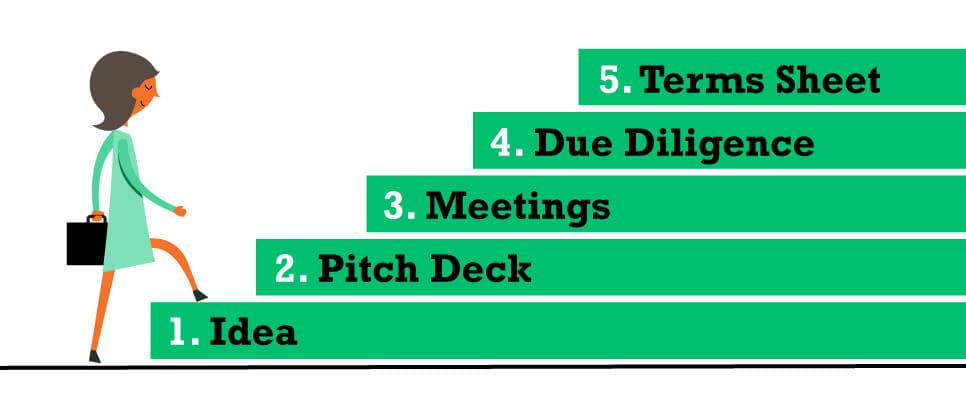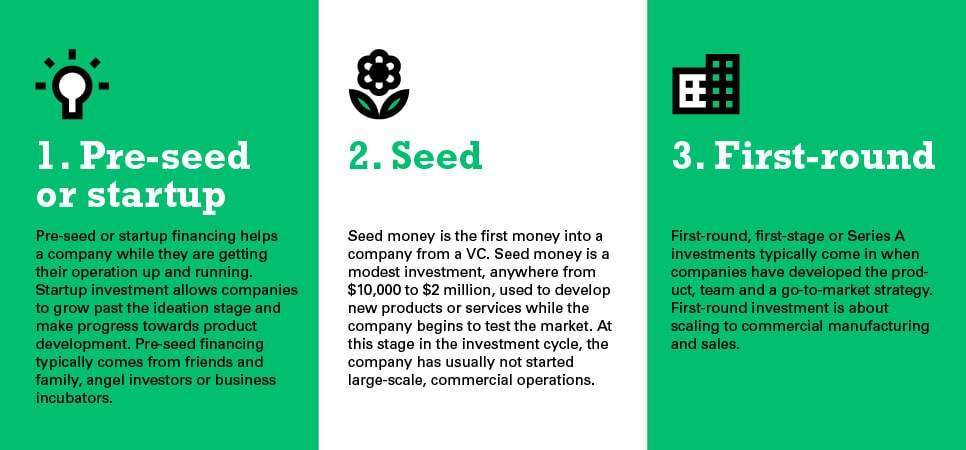There are many financing options for entrepreneurs looking to build their big ideas, but one of the most sought after is venture capital (VC) funding.
In this article, we’ll cover the basics of VC, provide general tips on how to know if it’s the right funding option for your company and give an overview of the process. We’ll also explain the first three tiers of VC deals: pre-seed or startup, seed and first-round.
This first article will cover the ideas on a general level, and we’ll further explain some of the most critical lessons — like finding the right VC and successfully pitching them - in subsequent posts. So read up, do your homework, then get out there and begin pitching.
What is venture capital?
Moula offers the following definition for VC:
“Venture capital (VC) is finance provided to start-ups and small-to-medium enterprises that are seen to have high growth potential that exceeds that of most businesses. Venture capital investors usually are high net worth individuals, venture capital firms, investment banks or a range of other financial institutions. In exchange for taking the risk investing in early-stage companies, they expect a high return.”
VC is also sometimes referred to as “risk capital,” because there’s a risk of VCs losing their money if the early-stage business doesn’t succeed.
VCs is funded by institutional and private investors.
Venture capital
firms acquire funds from institutional investors such as pension funds, university
endowments and financial firms or high net worth individuals like former entrepreneurs or
angel investors. VCs then invest these funds in companies with hopes of achieving a
significant return.
VCs invest in return for equity.
Venture capital investments are typically made in
exchange for an , or part ownership, in a company, as opposed to being structured as loans.
VC investments include long-term partnerships between companies and venture capital
firms.
Venture capitalists don’t just give you money and walk away. They often want
to attend your meetings, help make decisions and give their input on how to run your
company. A VC firm will stick by your company’s side until it “exits” by “going public” in an IPO or getting
“acquired” or “bought out” by a private equity firm or larger company … and that can take a
while.
Typical exit periods are 5-7 years. Kindrik Partners Singapore recommends the latter, “Anything shorter than 5 years is not market standard and 7 years is preferable.”

🙅 Don’t think VC is right for your company? Learn about other financing options in “Everything You Need To Know About Financing A Business But Never Asked.”
Is my company ready for VC?
The right moment to approach VCs for investment is different for each company. It’s possible to attract a VC partner with only an idea, but the majority of deals are closed after a business has three concrete items:
- a founding team
- a minimum viable product (MVP)
- customers
In addition to these items, Investment Network India also recommends the following intangible assets.
- The potential for a solid return
- A good reason to invest
- A business structured for investment
- The opportunity to be actively involved
- A viable exit strategy
Early stage ventures are characterised by where they are in the business lifecycle. They are typically highly focused on product development and testing product-market fit, establishing their first team of employees and trying to get execution down pat. Depending on the nature of the product, these businesses may be ‘pre-revenue’ — in other words, not focused on sales. Highly technical startups may be focused on getting their solution right before they take it to market at all, whereas consumer-facing products might prioritise going to market in order to more rapidly acquire customer feedback, which will in turn inform further product development.
Investors who focus on early stage ventures understand that they are taking a high amount of risk, for the potential of a super-high return. For this reason, securing funding may take longer as investors spend more time with a business to properly assess its merits.
If your business hasn’t progressed far enough yet to attract venture capitalists, a might be a good first stop. Incubators like Ideaspace Foundation, Booost Incubator and Mktplace Ventures, offer resources, mentorship and office space, as well opportunities to get smaller amounts of capital (usually less than $25,000 , whereas the average seed-round VC deal can vary between $100,000 to $2 million AUD.
The 5 Steps to Getting VC Startup Funding
So you’ve decided VC is the right financing channel for your company, and you think your company is mature enough to pursue it. Now you need to understand and prepare for the funding process.
As a business founder, you’ll likely go through five steps on the path to VC funding:

1. Idea
First of all, you need a great business idea. But as we’ve
mentioned, not every business is right for a VC investment. Early stage venture capital
firms invest in specific kinds of companies: typically early-stage, highly-scalable
businesses that can grow fast, dominate a market and go public through an IPO. If you want
to raise capital from one, you’ll have to ensure your business fits this bill;
otherwise, a different type of financing may be your best bet.
2. Pitch
A pitch deck is generally the first piece of marketing
collateral you will share with a VC firm. A pitch deck can be cold-emailed to a firm, but
the best-case scenario is to get a warm intro, which is when someone from your network
introduces you to the VC.
Early-stage pitch decks are often conceptual and idea-based, whereas decks for later stages of funding are more complex, featuring KPIs such as engagement, traffic or revenue.
(Some entrepreneurs prefer to showcase their product in the first meeting in place of a deck. However, if the VC shows interest, the next step is almost always a traditional pitch deck or business plan.)
For tips on making a great pitch deck, visit ‘How to get VC funding from start to finish’.
3. Meetings
To secure financing for your business, you need to meet with
VCs. Cold-emailing your pitch deck to VCs is a potential way to score a meeting. However,
you’ll be much better off utilising your network as explained above.
To find the best fit, create a target list of VCs that align with your business. offers an extensive database of firms located in APAC, that you can search to find financiers in your industry. Then, use your network for referrals to get in touch with VCs, or do cold outreach as a last resort.
The timeline for getting a meeting is different for everyone. If you have a hot idea and a strong network with direct VC connections, it’s possible to get meetings set up within a few weeks.
But if you don’t have contacts, securing a meeting can take a long time. Paul Bassat, co-founder of Square Peg Capital and early investor in Australian unicorn Canva, likes to meet founders very early on in their journey and spend a lot of time getting to know them before investing.
4. Due diligence
If your first meeting with a VC goes well, there will be
additional meetings—the exact number varies greatly—and a series of due
diligence steps before a VC offers a deal. According to Caravell Singapore, the due
diligence process can take 2-4 weeks. Due diligence includes reviewing the founding team,
product, industry, target market, company earnings power and financial viability of the
company.
No matter how “done” your deal seems, the due diligence phase is necessary for all venture capital firms. The firm will take time to fact-check all important data and assess current assets alongside any potential risks, eventually determining whether the deal is a good fit.
5. Terms sheets & funding
If a VC wants to finance your company, they
will send over a term sheet that lays
out the details of the proposed deal. The terms sheet is a negotiable document that both
parties must agree upon. After finalising a terms sheet, the company will receive funding.
We’ll cover the specifics of terms sheets in a future post.
These five steps are the general process of securing funding from a VC. It’s not always a straight line to funding, so come prepared and remain persistent during the process.
#1 Cloud ERP
Software
How long is the VC process?
“Inertia is real. You can’t expect an organisation to become innovative right away. It’s a mindset and cultural change,” says Ayala Corporation managing director, Paolo Borromeo. Ayala Corporation have recently invested millions in the Filipino startup economy, thanks to its incubator, Kickstart.
“Big businesses like ours, honestly, have been used to big merger-acquisition projects. Startups are like 10-year experiments, something we had to learn over time.”
You don’t want to run out of money while building your business. So when approaching the VC funding process, it’s imperative to give yourself plenty of time.
Chris Quirk, investment manager at Rampersand, suggests the sooner the better. “If you haven’t been in touch with a VC and you are trying to raise immediately, then that’s probably too late.”
The first three tiers of VC funding
For most businesses, the first interaction with a VC will take place in its early-growth stages. Early-stage venture capital financing includes three :

In APAC, early stage funding dominated the VC investment landscape in the last quarter of 2020. Keep in mind though, some entrepreneurs get their seed or startup money from friends and family, business loans, alternative lending sources or other financing devices before approaching VCs.
💡 Stay tuned: You can learn more about how to get VC funding in our upcoming articles.









